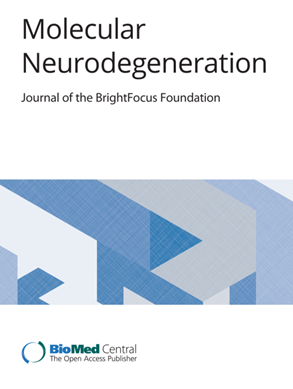Interrogating the plasma proteome of repetitive head impact exposure and chronic traumatic encephalopathy
IF 17.5
1区 医学
Q1 NEUROSCIENCES
引用次数: 0
Abstract
Exposure to repetitive head impacts (RHI) is associated with increased risk for chronic traumatic encephalopathy (CTE), a neurodegenerative tauopathy, and other neuropathological changes. Biological drivers of RHI-related neurodegeneration are not well understood. We interrogated the plasma proteome in aging adults with prior RHI compared to healthy controls (CTL) and individuals with Alzheimer’s disease (AD), including a subset characterized neuropathologically at autopsy. Proximity extension assay (Olink Explore®) quantified 2,779 plasma proteins in 22 RHI patients (all AD-biomarker negative), 39 biomarker-confirmed AD, and 44 CTL. A subset of participants went to autopsy (N = 16) allowing for comparisons of the antemortem plasma proteome between autopsy-confirmed CTE + (N = 7) and CTE- (N = 9). Differential abundance and co-expression network analyses identified plasma proteomic signatures of RHI, which were functionally annotated using gene ontology and cell type enrichment analysis. Nonparametric correlations examined plasma proteomic associations with orthogonally-measured plasma biomarkers, global cognitive function, and semi-quantitative ratings of neuropathology burden at autopsy. Differential abundance analysis revealed 434 increased (vs. 6 decreased) proteins in RHI vs. CTL and 193 increased (vs. 14 decreased) in RHI vs. AD. Network analysis identified 9 protein co-expression modules (M1-M9), of which 7 were elevated in RHI compared to AD or CTL. Modules with increased abundance in RHI were enriched for mitochondrial/metabolic, cell division, and immunovascular (e.g., cell adhesion, TNF-signaling) processes. RHI-related modules exhibited strong and selective correlations with immunoassay-based plasma IL-6 in RHI cases, including the M2 TNF-signaling/cell adhesion module which harbored proteins that strongly tracked with cognitive function. RHI-related plasma protein signatures were similar in the subset of participants with autopsy-confirmed CTE, including immune and metabolic modules that positively correlated with medial temporal lobe tau and TDP-43 burden. Molecular pathways in plasma most consistently implicated in RHI were tied to immune response, mitochondrial function, and cell metabolism. RHI-related proteomic signatures tracked with antemortem cognitive severity and postmortem neuropathological burden, providing converging evidence for their role in disease progression. Differentially abundant proteins and co-expression modules in RHI may inform mechanisms linking RHI to increased dementia risk, thus guiding diagnostic biomarker and therapeutic development for at-risk populations.反复头部撞击暴露与慢性创伤性脑病的血浆蛋白质组研究
暴露于重复性头部撞击(RHI)与慢性创伤性脑病(CTE)、神经退行性脑病和其他神经病理改变的风险增加有关。rhi相关神经退行性变的生物学驱动因素尚不清楚。我们研究了与健康对照(CTL)和阿尔茨海默病(AD)患者相比,先前患有RHI的老年人的血浆蛋白质组,包括尸检时神经病理学特征的一个子集。邻近扩展法(Olink Explore®)对22例RHI患者(全部AD生物标志物阴性)、39例生物标志物证实的AD和44例CTL的2779个血浆蛋白进行了定量分析。一部分参与者进行了尸检(N = 16),以便比较尸检证实的CTE + (N = 7)和CTE- (N = 9)之间的死前血浆蛋白质组。差异丰度和共表达网络分析确定了RHI的血浆蛋白质组学特征,并使用基因本体和细胞类型富集分析对其进行了功能注释。非参数相关性研究了血浆蛋白质组学与正交测量的血浆生物标志物、整体认知功能和尸检时神经病理学负担的半定量评分之间的关联。差异丰度分析显示,RHI与CTL相比增加了434个蛋白(6个蛋白减少),RHI与AD相比增加了193个蛋白(14个蛋白减少)。网络分析鉴定出9个蛋白共表达模块(M1-M9),其中7个在RHI中与AD或CTL相比升高。RHI丰度增加的模块用于线粒体/代谢、细胞分裂和免疫血管(如细胞粘附、tnf信号传导)过程。在RHI病例中,RHI相关模块与基于免疫测定的血浆IL-6表现出强烈的选择性相关性,包括M2 tnf信号传导/细胞粘附模块,其中包含与认知功能密切相关的蛋白质。在尸检证实的CTE参与者亚组中,rhia相关血浆蛋白特征相似,包括与内侧颞叶tau和TDP-43负担正相关的免疫和代谢模块。血浆中与RHI最一致的分子通路与免疫反应、线粒体功能和细胞代谢有关。rhi相关的蛋白质组特征与死前认知严重程度和死后神经病理负担有关,为它们在疾病进展中的作用提供了一致的证据。RHI中差异丰富的蛋白质和共表达模块可能为RHI与痴呆风险增加之间的联系机制提供信息,从而指导高危人群的诊断生物标志物和治疗开发。
本文章由计算机程序翻译,如有差异,请以英文原文为准。
求助全文
约1分钟内获得全文
求助全文
来源期刊

Molecular Neurodegeneration
医学-神经科学
CiteScore
23.00
自引率
4.60%
发文量
78
审稿时长
6-12 weeks
期刊介绍:
Molecular Neurodegeneration, an open-access, peer-reviewed journal, comprehensively covers neurodegeneration research at the molecular and cellular levels.
Neurodegenerative diseases, such as Alzheimer's, Parkinson's, Huntington's, and prion diseases, fall under its purview. These disorders, often linked to advanced aging and characterized by varying degrees of dementia, pose a significant public health concern with the growing aging population. Recent strides in understanding the molecular and cellular mechanisms of these neurodegenerative disorders offer valuable insights into their pathogenesis.
 求助内容:
求助内容: 应助结果提醒方式:
应助结果提醒方式:


